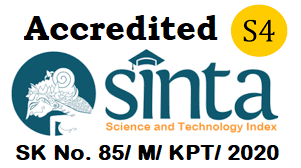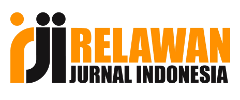Implementation of Lean Manufacturing to Reduce Waste with Value Stream Mapping Method and Waste Assessment Model in Konveksi Warsito Home Industry
Abstract
One of the home industry conventions warsito in the Pati area produces clothing products like pyjamas. This home industry is run by individuals or families on a small scale. Convex home industries often face the challenge of managing efficient production processes and meeting consumer expectations. Faced with such challenges, they often face problems of waste in the production process, such as excessive inventory, waiting times, unnecessary movements, and inefficient processes. Therefore, to eliminate such waste, the concept of lean manufacturing is needed. This research discusses waste reduction using the Value Stream Mapping (VSM) and Waste Assessment Model (WAM) methods. With this method, non-value added identification is produced through the process flow and the relationship of waste to each other. There are 2 largest wastes, namely waste defect and waste motion, which then require improvement proposals by analyzing the causes/root causes of the waste using a fishbone diagram. From this method, waste defect with a percentage of 20.452% and waste motion with a percentage of 16.16%. The improvement proposal for dealing with waste defects is to apply the 5s principle, group materials by type and color, schedule machine maintenance. At waste motion it is recommended to set the work position, use aids such as jig, quality control of materials, set a sewing machine calibration schedule.
References
Cahya, F., & Handayani, W. (2022). Minimasi Waste Melalui Pendekatan Lean Manufacturing pada Proses Produksi di UMKM Nafa Cahya. Al-Kharaj : Jurnal Ekonomi, Keuangan & Bisnis Syariah, 4, 1199–1208. https://doi.org/10.47467/alkharaj.v4i4.904
DeTreville, S., & Antonakis, J. (2006). Could lean production job design be intrinsically motivating? Contextual, configurational, and levels-of-analysis issues. Journal of Operations Management, 24, 99–123. https://doi.org/10.1016/j.jom.2005.04.001
El-Namrouty, K. A. (2013). Seven Wastes Elimination Targeted by Lean Manufacturing Case Study ″Gaza Strip Manufacturing Firms″. International Journal of Economics, Finance and Management Sciences, 1(2), 68. https://doi.org/10.11648/j.ijefm.20130102.12
Fananda, S. E., Zulfah, Z., & Luthfianto, S. (2022). Peningkatan Efisiensi dengan Metode VSM untuk Mengurangi Waste pada Line Assembly Proses Produksi Kapal Kayu. Tekinfo: Jurnal Ilmiah Teknik Industri Dan Informasi, 11(1), 1–13. https://doi.org/10.31001/tekinfo.v11i1.1547
Hidayat, R., Pambudi Tama, I., & Efranto, R. Y. (n.d.). IMPLEMENTATION OF LEAN MANUFACTURING USING VSM AND FMEA TO REDUCE WASTE IN PRODUCT PLYWOOD (Case Study Dept. Production PT Kutai Timber Indonesia).
Irawan, A., & Putra, B. (2021). Identifikasi Waste Kritis Pada Proses Produksi Pallet Plastik Menggunakan Metode WAM (Waste Assessment Model) Di PT. XYZ. Jurnal SENOPATI : Sustainability, Ergonomics, Optimization, and Application of Industrial Engineering, 3, 20–29. https://doi.org/10.31284/j.senopati.2021.v3i1.2098
Jufrijal, J., & Fitriadi, F. (2022). Identifikasi Waste Crude Palm Oil dengan Menggunakan Waste Assessment Model. Jurnal INTECH Teknik Industri Universitas Serang Raya, 8(1), 43–53. https://doi.org/10.30656/intech.v8i1.4387
Koh, J., & Singgih, M. (2021). Implementation Lean Manufacturing Method of Plywood Manufacture Company. IPTEK Journal of Proceedings Series, 25. https://doi.org/10.12962/j23546026.y2020i2.9022
Krisnanti, E. D., & Garside, A. K. (2022). Penerapan Lean Manufacturing untuk Meminimasi Waste Percetakan Box. Jurnal INTECH Teknik Industri Universitas Serang Raya, 8(2), 99–108. https://doi.org/10.30656/intech.v8i2.4780
Novitasari, R., & Iftadi, I. (2020). Analisis Lean Manufacturing untuk Minimasi Waste pada Proses Door PU. Jurnal INTECH Teknik Industri Universitas Serang Raya, 6(1), 65–74. https://doi.org/10.30656/intech.v6i1.2045
Prawira, Y., Ishak, A., & Anizar, A. (2024). A Review of Literature on Lean Manufacturing Tools and Implementation Based on Case Studies. Jurnal Sistem Teknik Industri, 26(1), 11–21. https://doi.org/10.32734/jsti.v26i1.11489
Rahayu Putri, A., Herlina, L., & Ferro Ferdinant, P. (2017). Identifikasi Waste Menggunakan Waste Assessment Model (WAM) Pada Lini Produksi PT. KHI Pipe Industries. In Jurnal Teknik Industri (Vol. 5, Issue 1).
Rawabdeh, I. (2005). A model for the assessment of waste in job shop environments. International Journal of Operations & Production Management, 25, 800–822. https://doi.org/10.1108/01443570510608619
Sundari, S., Gempito, A., & Suwarni, P. E. (2021). Identifikasi Pemborosan di Unit Penyaring Minyak Inti Sawit PT. SSS. www.jurnal.utu.ac.id/joptimalisasi
Yansen, O., & Yenny Bendatu, L. (2013). Perancangan Value Stream Mapping dan Upaya Penurunan Lead time pada Bagian Procurement-Purchasing di PT X (Vol. 1, Issue 2).

This work is licensed under a Creative Commons Attribution-NonCommercial-ShareAlike 4.0 International License.













